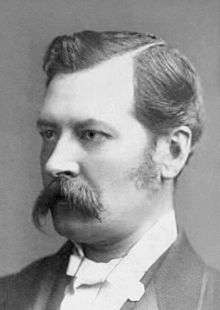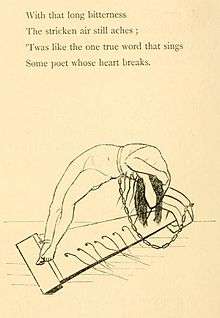Arthur O'Shaughnessy
Arthur William Edgar O'Shaughnessy (14 March 1844 – 30 January 1881) was a British poet and herpetologist.[1] Of Irish descent, he was born in London.[2] He is most remembered for his Ode, beginning with the words "We are the music makers, / And we are the dreamers of dreams", which has been set to music by several composers including Edward Elgar as (as The Music Makers), Zoltán Kodály, Alfred Reed and, more recently, Aphex Twin (Selected Ambient Works Vol. 1).

Early life and herpetology
At 17, in June 1861, Arthur O'Shaughnessy received the post of transcriber in the library of the British Museum, reportedly through the influence of Sir Edward Bulwer Lytton. Two years later, he became a herpetologist in the museum's zoological department. From 1874 to his premature death, he described six new species of reptiles, and after his death, he was honoured in the specific name, oshaughnessyi, of four new species of lizards described by Albert Günther and George Albert Boulenger.[1]
Poetry
However, O'Shaughnessy's true passion was for literature. He published his first collection of poetry, Epic of Women, in 1870, followed two years later by Lays of France in 1872, and then Music and Moonlight in 1874. When he was 30, he married and did not produce any more volumes of poetry for the last seven years of his life. He died at only 36 from a "chill" after he walked home from the theatre on a rainy night.[3] His last volume, Songs of a Worker, was published posthumously in 1881. Although denigrated by T. S. Eliot as a 'minor poet' in an influential 1957 essay,[4] O'Shaughnessy was both formally and aesthetically cutting-edge. For example, he is one of the only Pre-Raphaelite poets to have needed a steady income, and his corpus often explores the relationship between art and work. Unlike other Pre-Raphaelites, O'Shaughnessy saw poetry as the result of toil rather than the consequence of a moment's frenetic inspiration.[5]
Personal life
The artists Dante Gabriel Rossetti and Ford Madox Brown were among O'Shaughnessy's circle of friends, and in 1873, he married Eleanor Marston, the daughter of author John Westland Marston and the sister of the poet Philip Bourke Marston. Together, he and his wife wrote a book of children's stories, Toy-land (1875). They had two children together, both of whom died in infancy. Eleanor died in 1879, and O'Shaughnessy himself died in London two years later from the effects of a "chill". He is buried in Kensal Green Cemetery.
Legacy
The anthologist Francis Turner Palgrave, in his work, The Golden Treasury declared that of the modern poets, despite his limited output, O'Shaughnessy had a gift that in some ways was second only to Tennyson and "a haunting music all his own".

O'Shaughnessy's translations of Parnassian poetry, and the influence of French decadence on his own work, were crucial in setting the stage for English-language decadence in the 1890s. Jordan Kistler writes that he was "instrumental in bridging the gap between the Pre-Raphaelitism practised by poets such as D. G. Rossetti and William Morris in the 1870s and the aestheticism of the 1890s"[6].
O'Shaughnessy is commemorated in the scientific names of four species of lizards: Calumma oshaughnessyi, Cercosaura oshaughnessyi, Enyalioides oshaughnessyi, and Pachydactylus oshaughnessyi.[1]
Works
- An Epic of Women (1870)
- Lays of France (1872)
- Music and Moonlight: Poems and Songs (1874)
- Toy-land (with Eleanor W. O'Shaughnessy) (1875)
- Songs of a Worker (1881) (published posthumously)
Sources
- Arthur O'Shaughnessy: Music Maker by Molly Whittington-Egan (2013) Bluecoat Press
- Arthur O'Shaughnessy, a Pre-Raphaelite Poet in the British Museum by Jordan Kistler (2016) Routledge
References
- Beolens, Bo; Watkins, Michael; Grayson, Michael (2011). The Eponym Dictionary of Reptiles. Baltimore: Johns Hopkins University Press. xiii + 296 pp. ISBN 978-1-4214-0135-5. ("O'Shaughnessy", p. 197).
- Moulton, Louise (1894). Arthur O'Shaughnessy: his life and his work, with selections from his poems. Cambridge and Chicago: Stone & Kimball. 120 pp. Retrieved 9 August 2011.
- Poetry Foundation. www.poetryfoundation.org/bio/arthur-oshaughnessy.
- T.S. Eliot, 'What is Minor Poetry?', On Poetry and Poets (London: Faber, 1957), p.39.
- Jordan Kistler, Arthur O'Shaughnessy, a Pre-Raphaelite Poet in the British Museum (Abingdon: Routledge, 2016) p.61
- Jordan Kistler, Arthur O'Shaughnessy, a Pre-Raphaelite Poet in the British Museum (Abingdon: Routledge, 2016) p.140
External links




- Works by or about Arthur O'Shaughnessy at Internet Archive
- Works by Arthur O'Shaughnessy at LibriVox (public domain audiobooks)

- List of O'Shaughnessy papers held at Queen's University Belfast